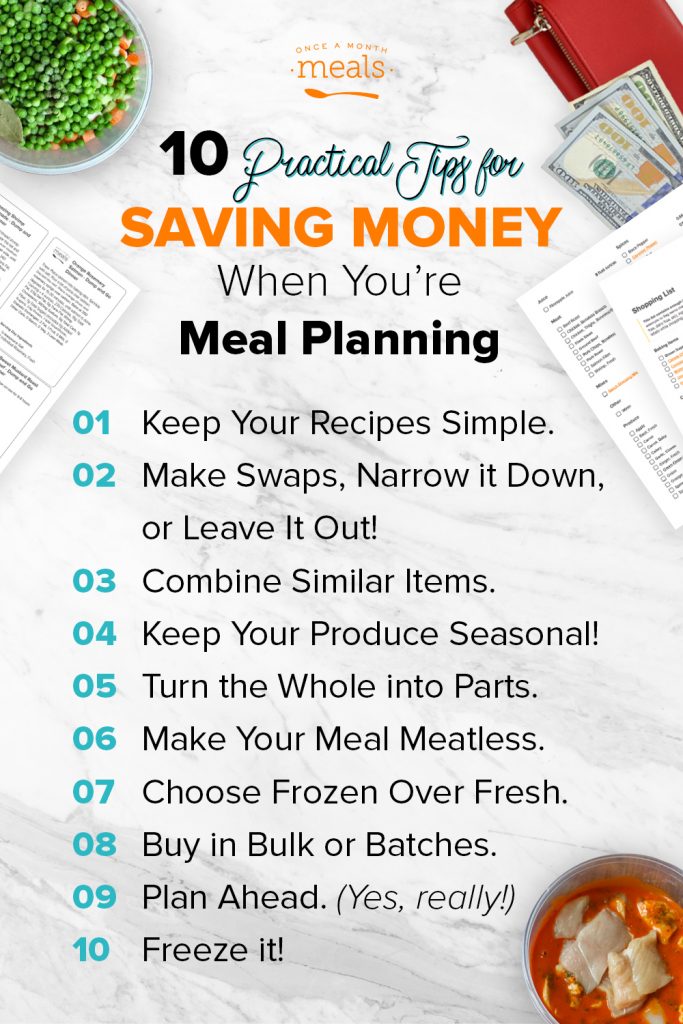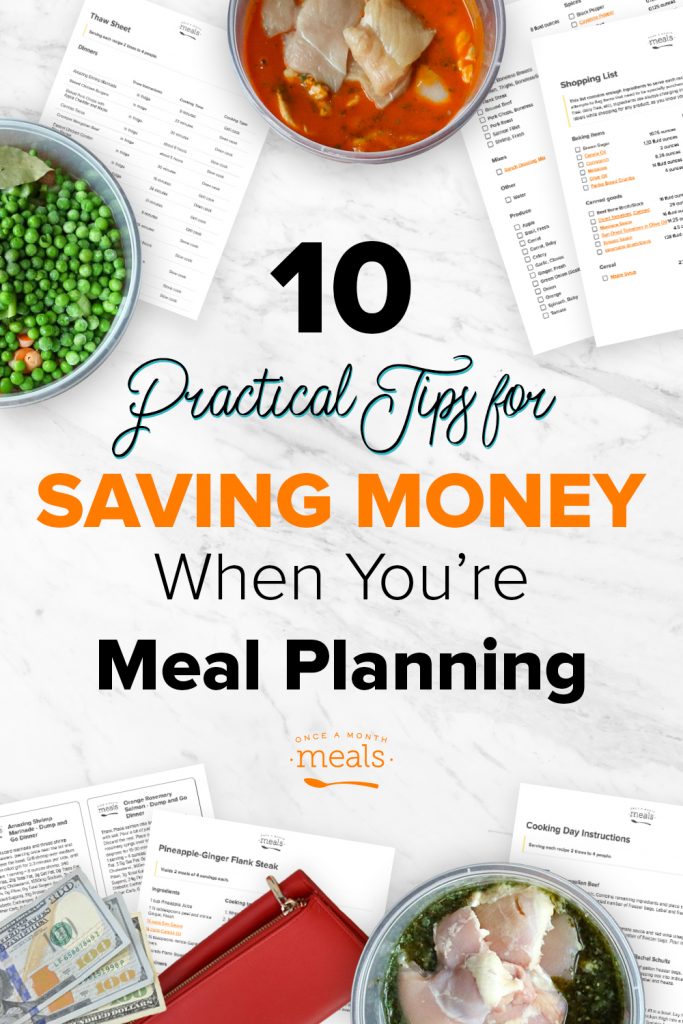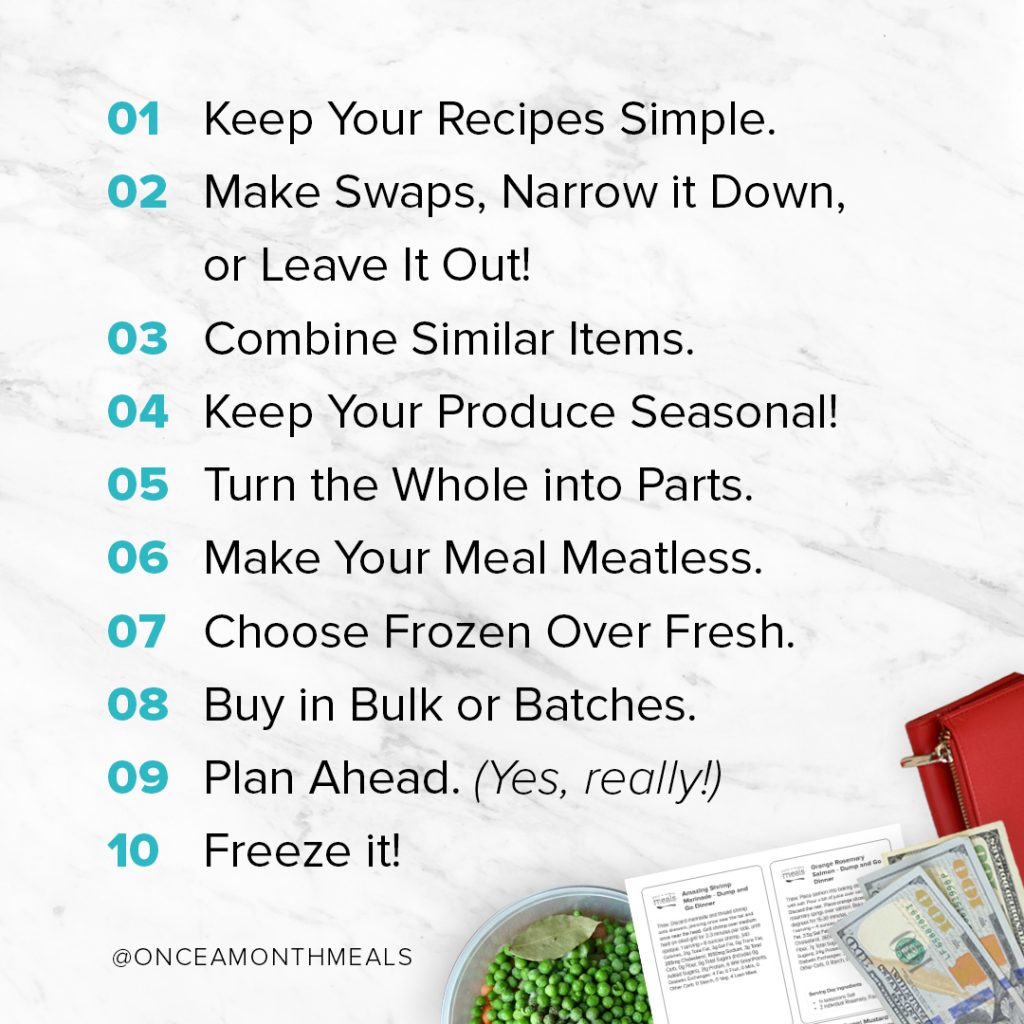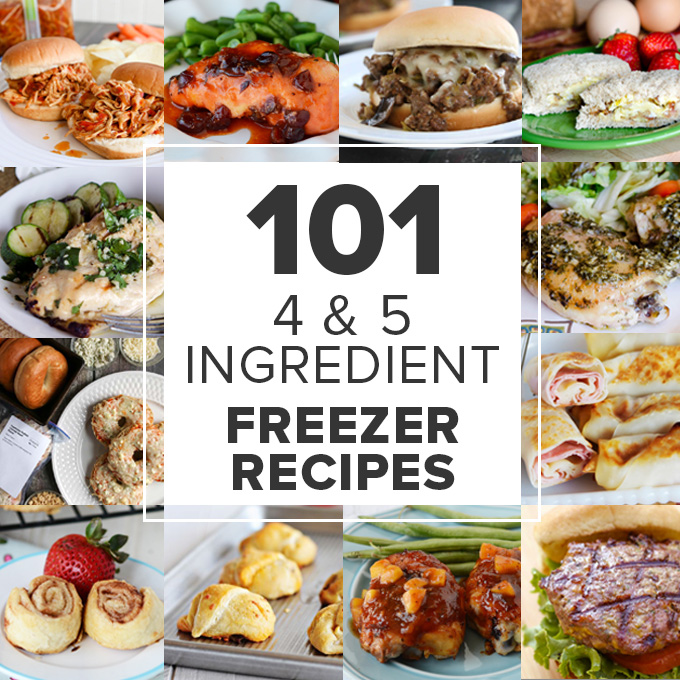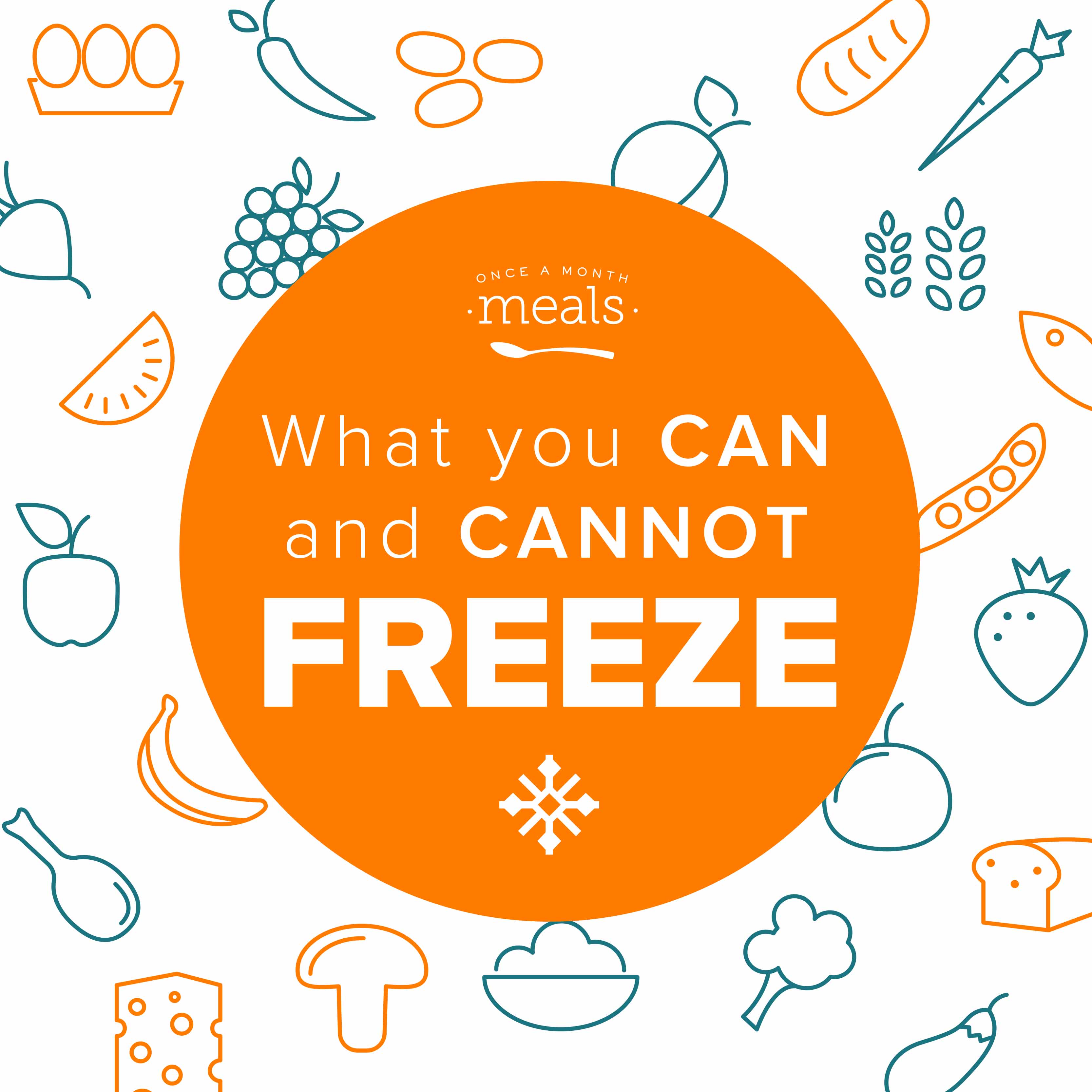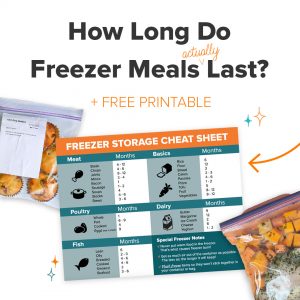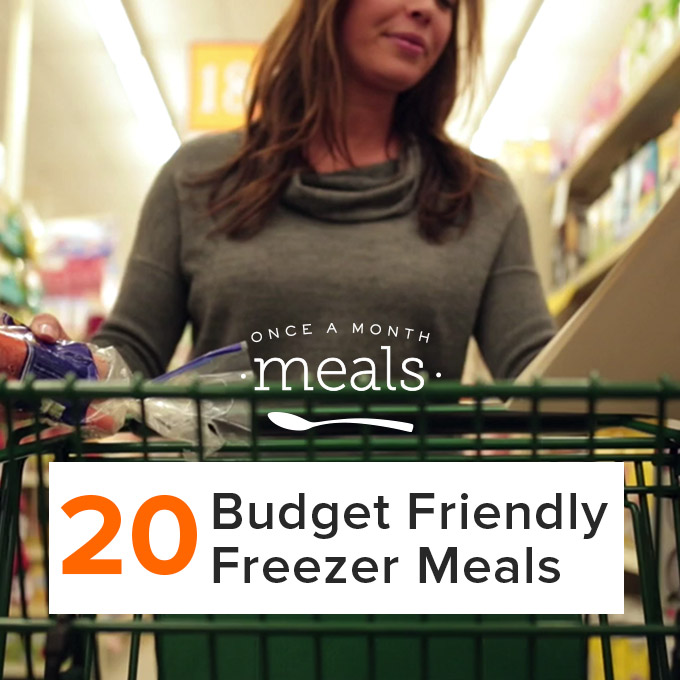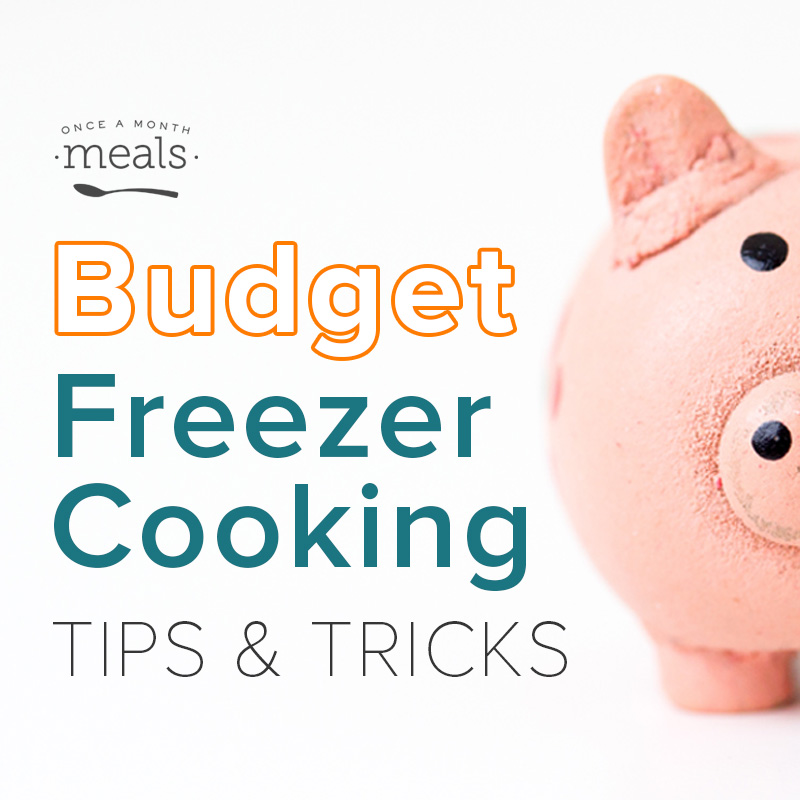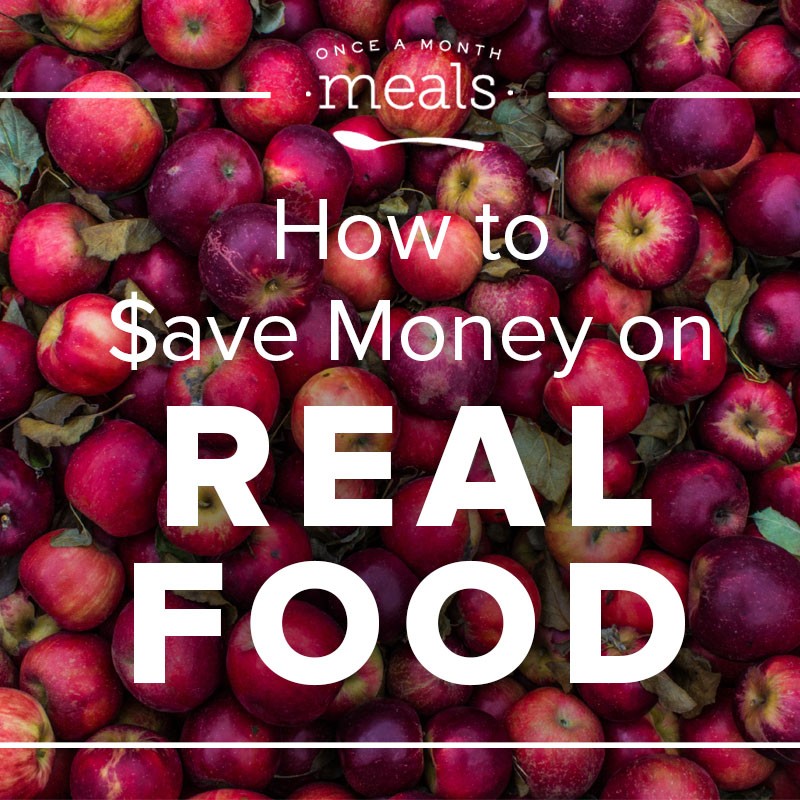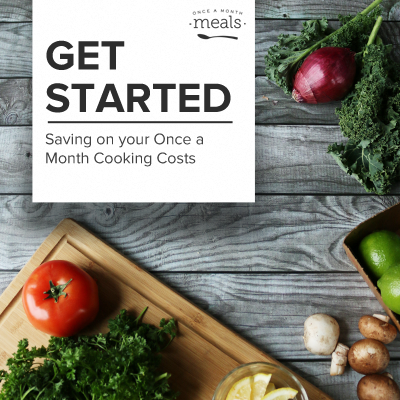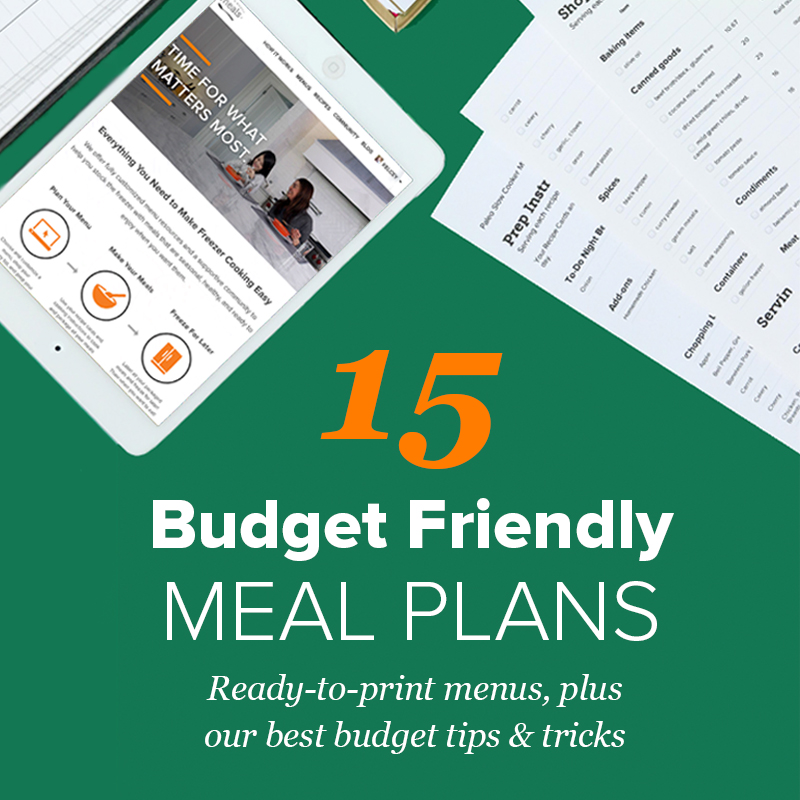“Cooking on a Budget” –– Do we hear a Yay or Nay? At OAMM we’re all about saving money when you’re meal planning!
Let’s be honest, it can sometimes feel like the majority of the world (at least here on the Internet) are posting beautiful pictures of their perfectly healthy, gourmet meals and you’re over here with #nofilter trying to keep it real with boxed mac-n-cheese and rotisserie chicken to keep the growing minions in your home happy… while also sticking to a budget.
Can anyone relate?
Let’s be honest –– feeding your people well without spending too much IS really difficult. No question about it.
You’ve tried what feels like everything:
- Ordering groceries online to limit your impulse purchases
- Digitally and physically clipping coupons to save a few bucks
- Using fancy apps that tell you where the best deals are
- Going out of your way to purchase at discount grocery stores
- Paying expensive memberships to money-saving meal planning services
The list could go on and on and is exhaustive, right?
The goal for each of us?
To provide healthy, home-cooked meals that don’t break the bank.
Enter these tips to the rescue!
10 Practical Tips for Saving Money While Meal Planning
We’ll be providing you tips, tricks, resources, and more to help you and your family save your pennies on food, so you can spend them on the things you want –– an upcoming vacation, paying off your car, or even that new sweater you want from Target (#judgementfree zone here!)
Our Goal: To help you practically plan your meals (no fancy gimmicks here) and to use your ingredients to their fullest potential – so you can use that money on what you want!
We want to help you:
- Be strategic in choosing meals when you’re planning
- Drastically cut down on your food waste (aka throw away less!)
- Use the ingredients you have to the maximum
- Find more resources for loads of budget-saving recipes (and grocery shopping lists!)
- Feed your family whole, real food meals that still taste really good.
- Feel confident you can reach your financial goals with these money-saving tools
Regardless of how you want to spend your money, we’re here to help you learn to save a little more of it when it comes to food.
Who’s ready?
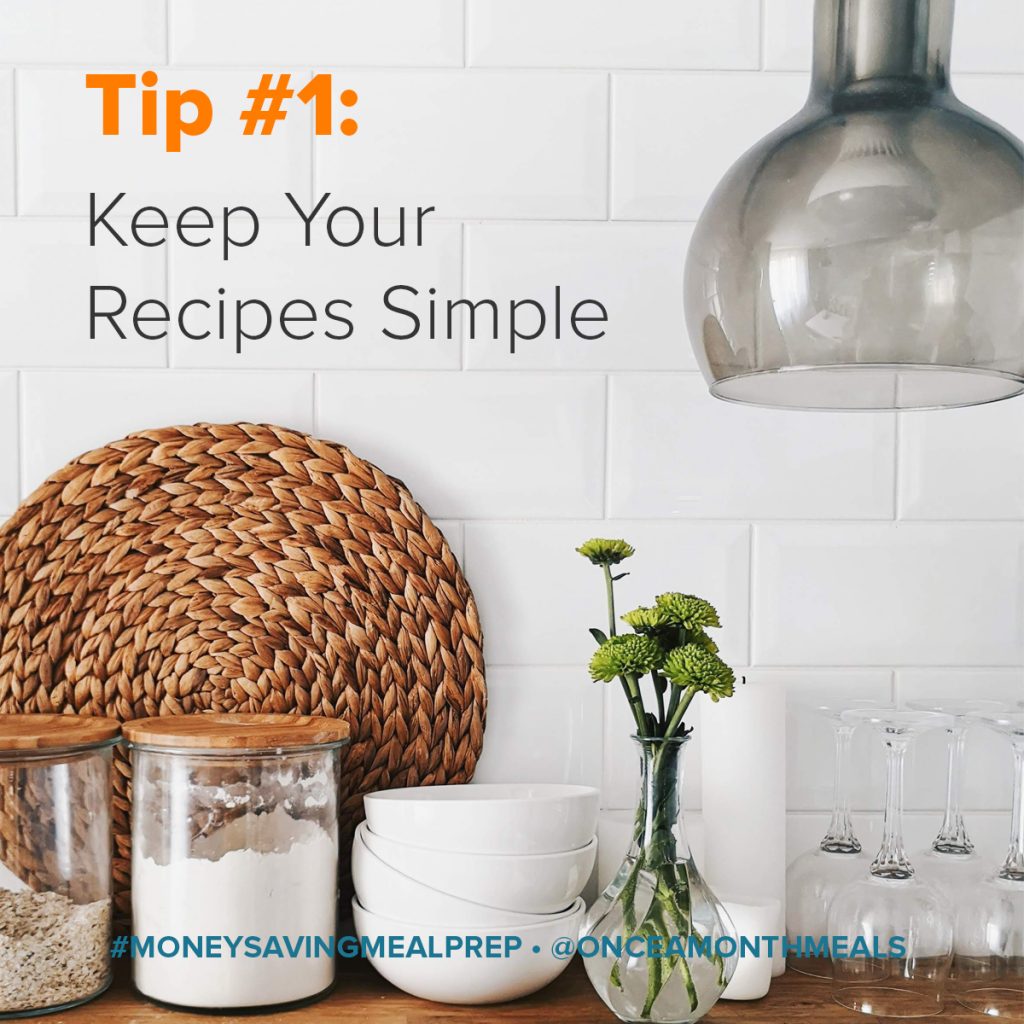
Tip #1: Keep your Recipes Simple
I don’t know about you, but sometimes we can just get carried away with a fancy recipe with a long list of fancy ingredients and probably some fancy new kitchen gadget needed too! Before we know it, we’ve blown our whole grocery budget on one recipe, and then we just pray that we have lots of leftovers.
Suffice it to say, it is COMPLETELY acceptable to stick to simple recipes to save some cash.
When making your meal plan (with us or anyone else), simply delete or swap out recipes that are too complicated for your budget.
To make it even simpler, maybe even put a limit on the number of ingredients each recipe can have so your next grocery list isn’t a mile long!
We have a list of 101 4&5 Ingredient Freezer Meals that are sure to get you started in the right direction. You can also filter our recipes by using the tag “5 ingredients or less”.
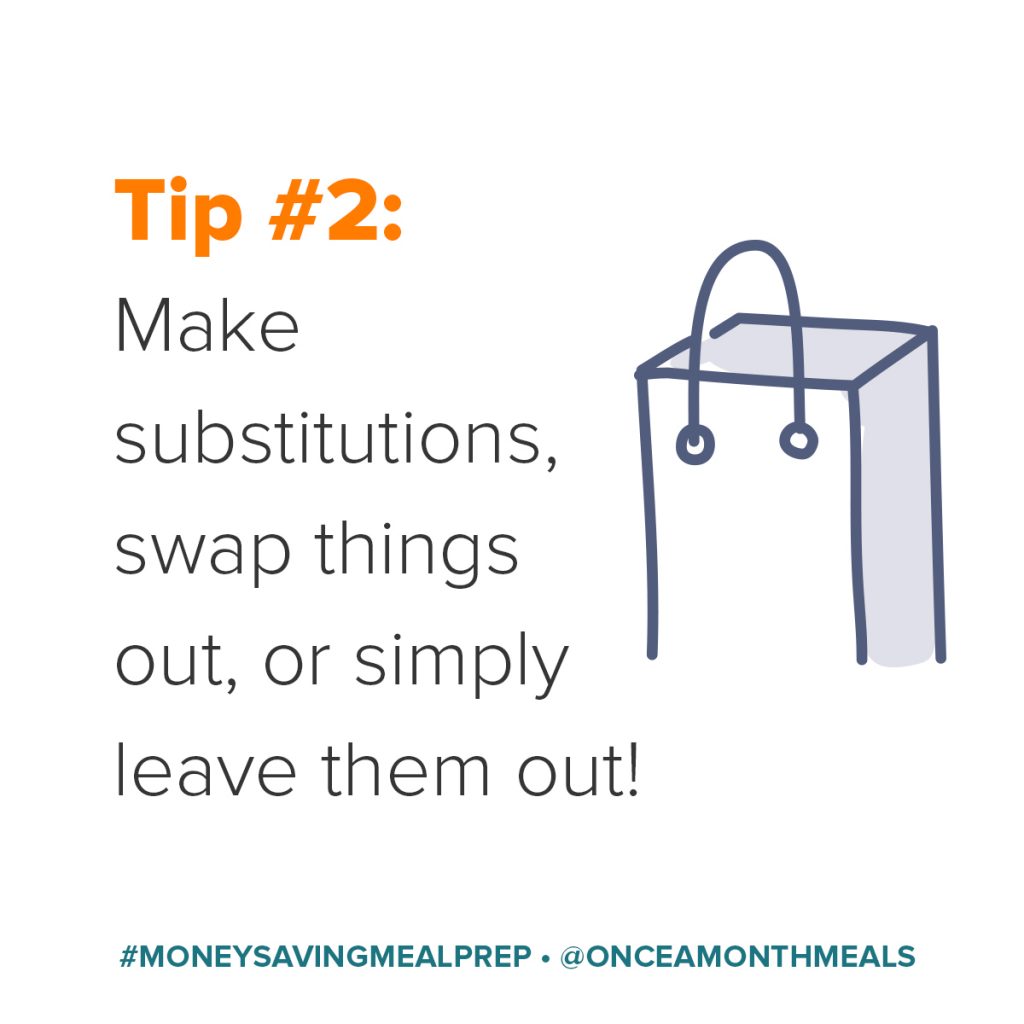
Tip #2: Make Swaps, Narrow It Down, or Leave It Out!
Did your recipe call for two different types of flour, and maybe 3 different cooking oils?
Think and check your recipes to see if you could get away with using the cheapest one in all of the recipes!
⇨ There’s no need to buy three when one will work for all of them!
This obviously is harder for those with dietary restrictions, but here are your goals:
- Swap It Out.
Think ahead of what you can use and reuse in several recipes. Swap and substitute things that you do have for the things that you don’t.
Ex: cooking flours, oils, nuts, veggies, certain meats, and so on. - Narrow it down.
It calls for multiple similar items, narrow it down to what you absolutely need. The cooking oils example above is a perfect example. - Simply leave it out.
(Especially if that ingredient isn’t super crucial to your recipe.) You obviously need chicken for Chicken Parmesan, or eggs for a Bacon & Egg Quiche. But maybe it’s a certain spice or an extra veggie it calls for. Your family will never know it called for peppers if you don’t say anything, so save yourself the trouble and the money!
Don’t waste your money trying to get everything on the list to make it complete if it’s going to bust your budget.
We hereby give you permission to leave things out! It’s O-K-A-Y!!
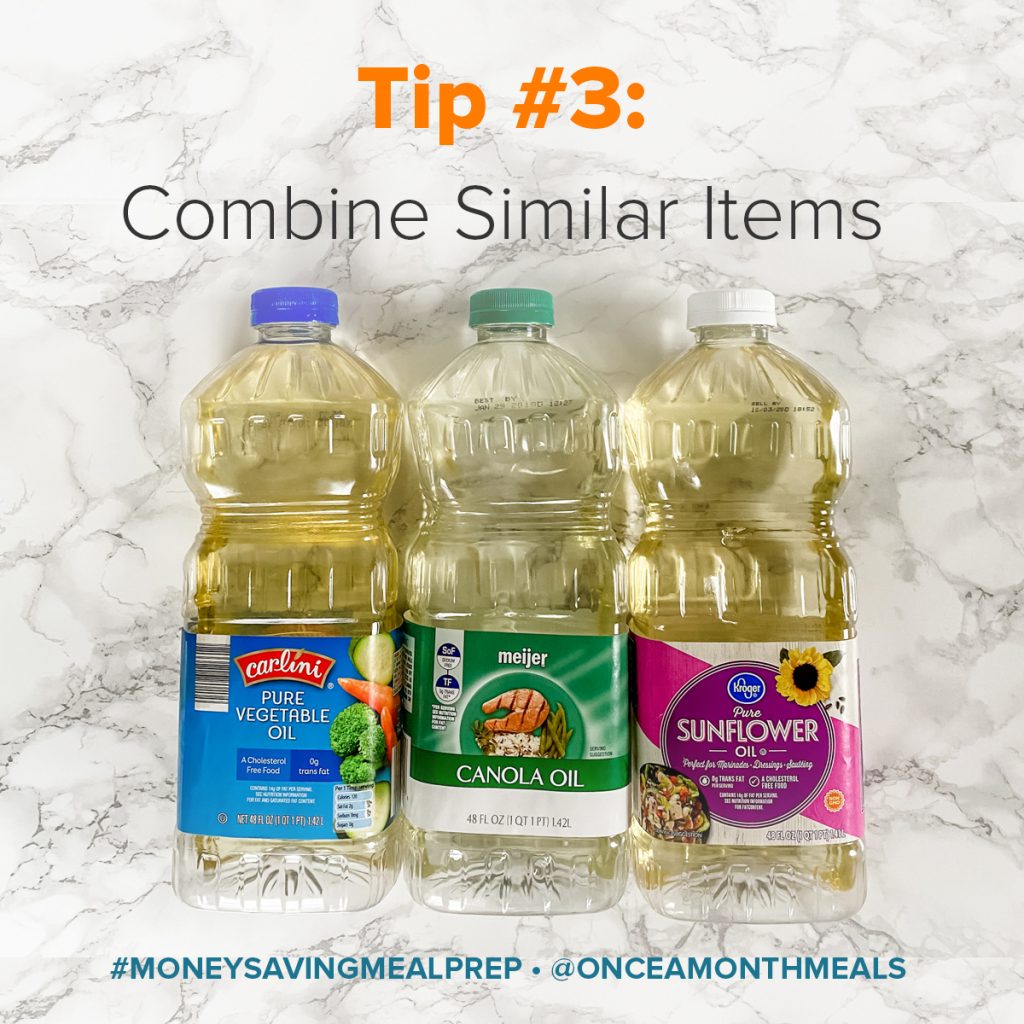
Tip #3: Combine Similar Items
- Do you ever run low on flour at the last minute?
- Not enough oil to make a full cup?
- Only have half the amount of broccoli you need?
Combine it with something you do have!
Half the amount of almond flour?
Add in another half of coconut flour, tapioca flour, all-purpose, or something else in your cupboard!
Part of a cup of olive oil?
Add in coconut oil, peanut oil, avocado oil, sunflower oil, etc.
Only half the amount of broccoli?
Add in green beans, peppers, squash, or another vegetable to even it out!
The sum of it is: Don’t make a last-minute grocery run if you don’t need it! Save yourself the trip and money!
Don’t forget to save this for later! Check out more budget freezer tips!
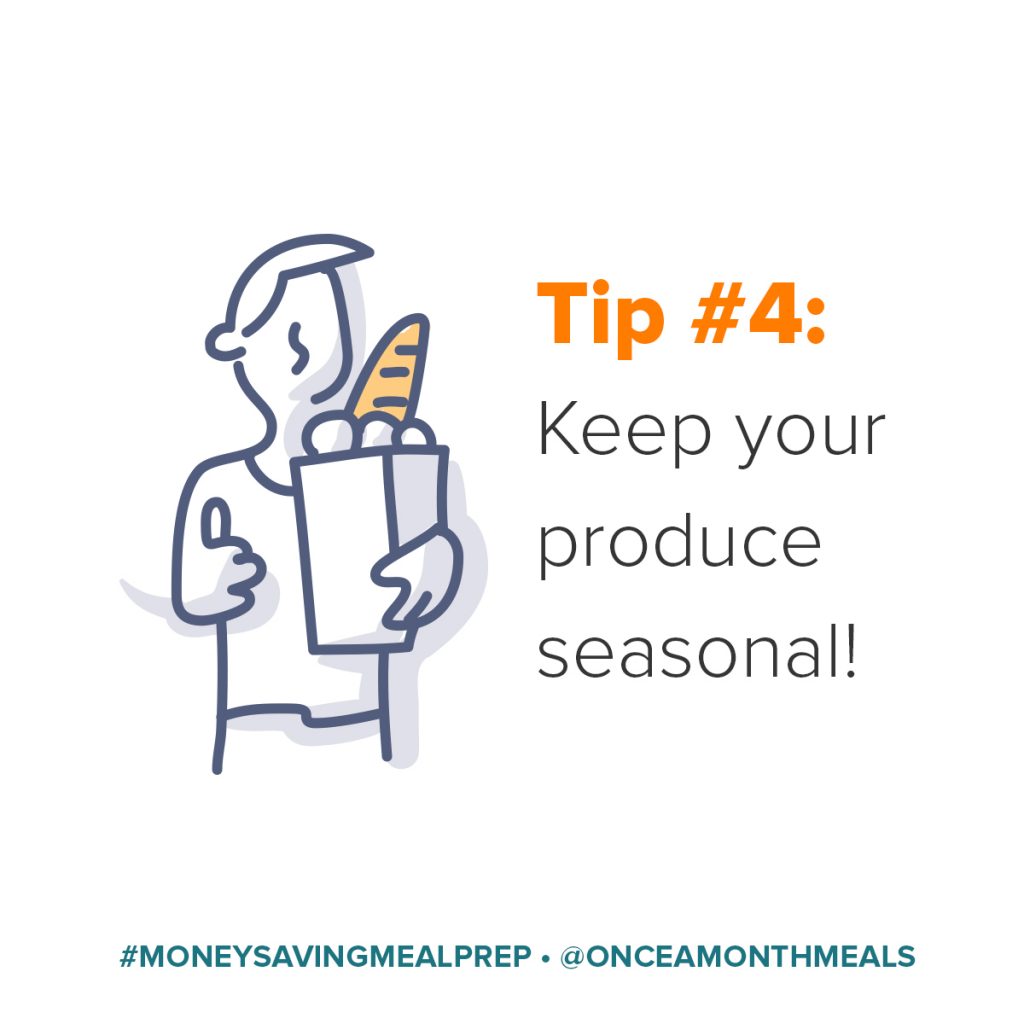
Tip #4: Keep Your Produce Seasonal!
One of the most important principles of efficient grocery shopping and meal planning is to purchase in-season items.
You probably know produce has different seasons when prices are the lowest and quality is the best, but almost everything in the grocery store has a “sale or seasonal cycle” that falls into either:
- Fall
- Winter
- Spring
- Summer
Fun fact: A registered dietitian has planned ALL our meal plans and recipes around these seasons ahead of time so you don’t have to!
If you want to see a glimpse, you can filter all our recipes by season (under categories) here!
That is why you will see extra grilling meats on our plans in the summer, and cranberries in mid-fall. Learning the season and sale cycles can help you so you aren’t tired of pumpkin recipes in September before they are actually at their lowest price in October.
So what can you do?
- Hunt grocery fliers and farmer’s markets for the best price throughout the month (and freeze those perishables until needed)
- Cook a little extra to take advantage of rock bottom prices on items like ground beef or chicken breast, or to even preserve the fruits of your labor from your annual apple picking trip.
Whatever it is, look for items that are in season! That is one simple way to go about saving money when you’re meal planning!
Here’s our list of each season by month, and what produce we recommend you look for! (+ Loads of seasonal recipes!)
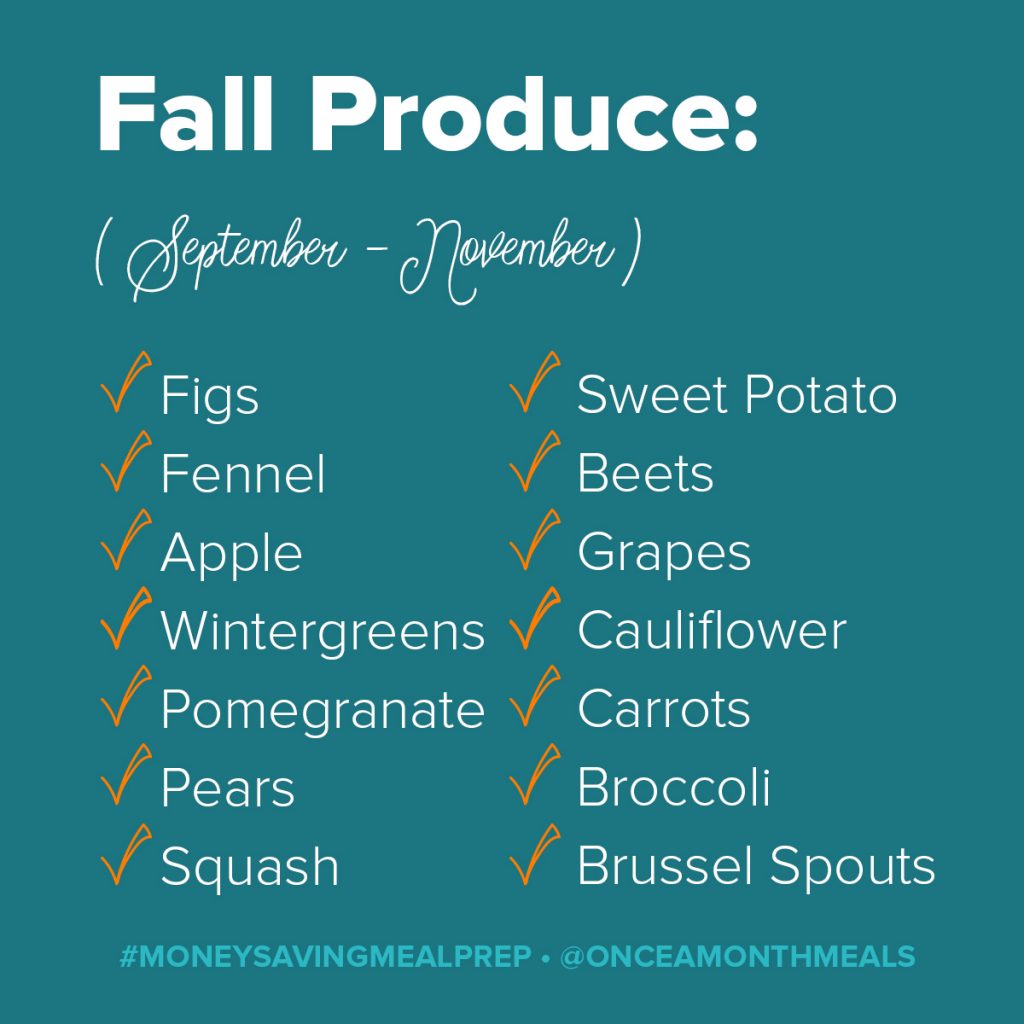 Fall Produce & Recipes
Fall Produce & Recipes
Use our Fall peak produce picks list & recipes as you start to see new items appear at your farmer’s market and in your CSA boxes. Happy harvest!
- 101 Fall Freezer Meals
- Fall Peak Produce Picks + Recipes
- Freezer Friendly Fall Recipes (12,370+ recipes to choose from!)
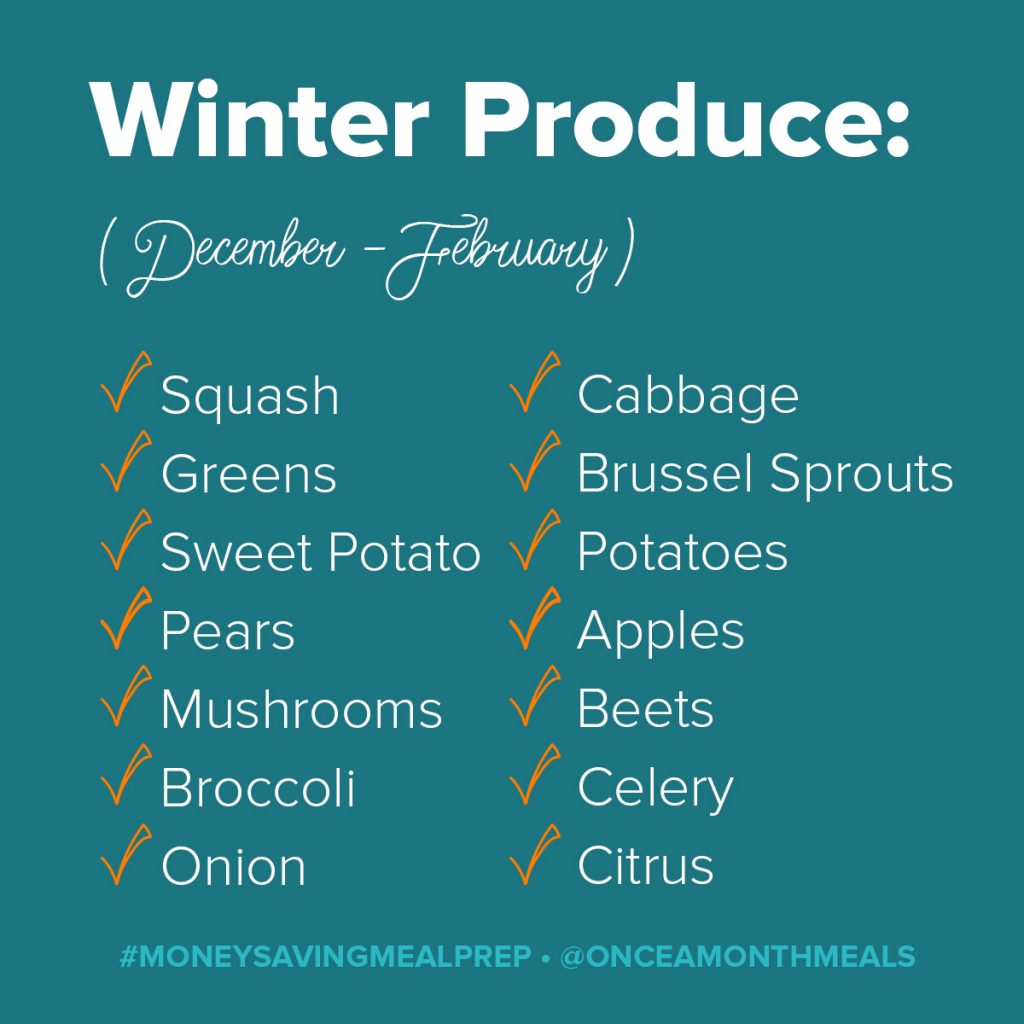 Winter Produce & Recipes
Winter Produce & Recipes
Be prepared this winter! We have loads of winter freezer meals so you have meals to eat at a moment’s notice to keep the comfort food and warmth coming all season long.
- 101 Winter Freezer Meals
- Winter Peak Produce Picks + Recipes
- Freezer Friendly Winter Recipes (10,980+ recipes to choose from!)
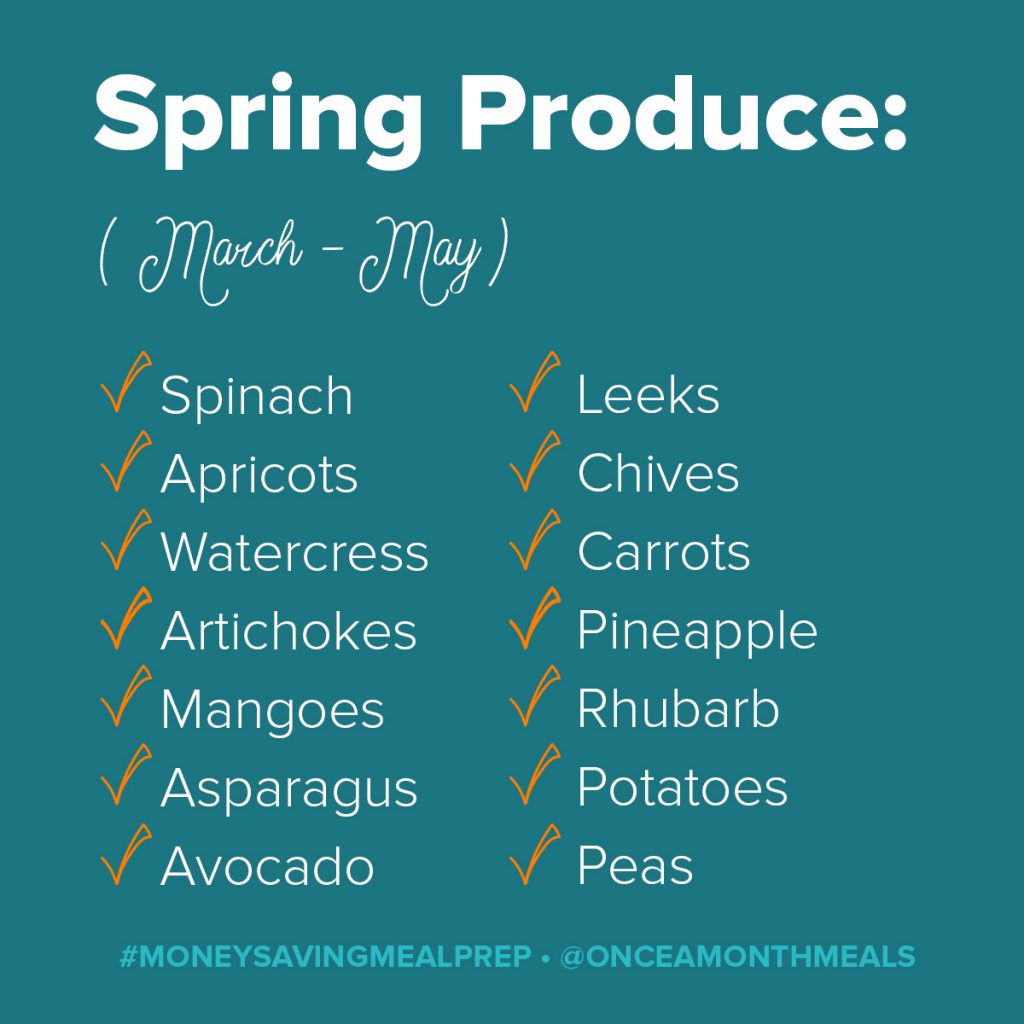 Spring Produce & Recipes
Spring Produce & Recipes
Spring is in the air! Keep sane as the busy season picks up with these spring freezer meals and make the most of spring peak produce by cooking and freezing some of these recipes!
- 101 Spring Freezer Meals
- Spring Peak Produce Picks + Recipes
- Freezer Friendly Spring Recipes (11,680+ recipes to choose from!)
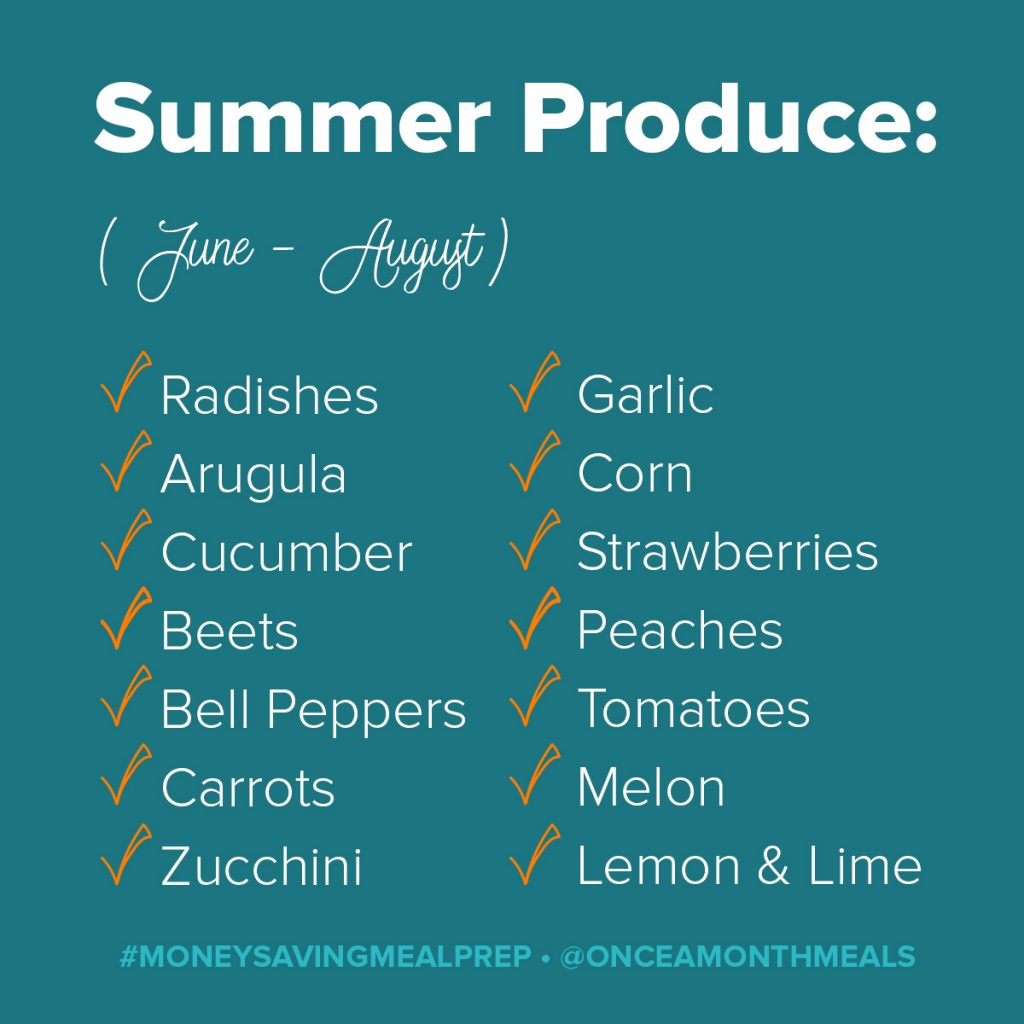 Summer Produce & Recipes
Summer Produce & Recipes
Summer arrives in all its glory with endless sunshine, heat, and humidity! Give yourself more time to play by stocking the freezer and make the most of summer peak produce with this list of seasonal, freezable recipes.
- 101 Summer Freezer Meals
- Summer Peak Produce Picks + Recipes
- Freezer Friendly Summer Recipes (10,240+ recipes to choose from!)
So what’s your favorite season to eat in?
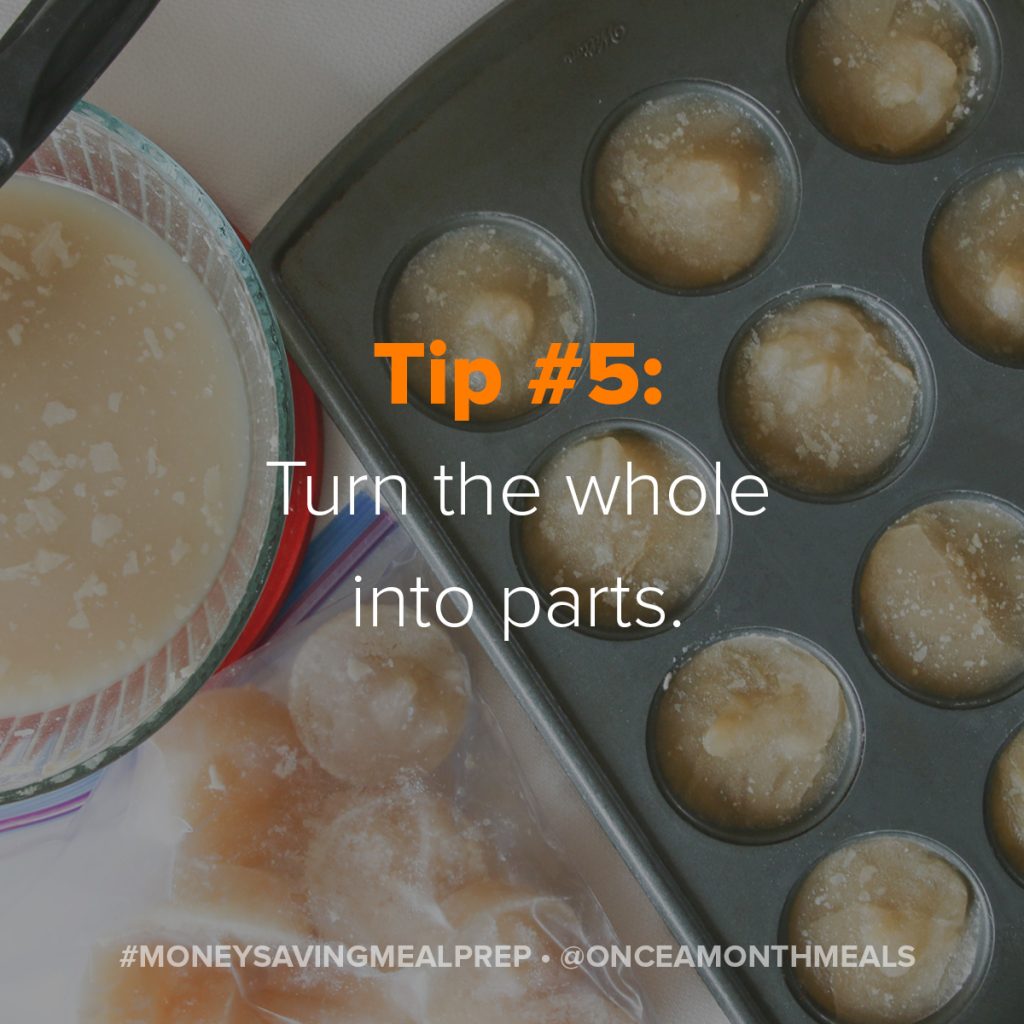
Tip #5: Turn the Whole into Parts
One of our favorite methods for saving money is to use every last bit of what we buy.
For example, did you know there is more to chicken than the breast? We say that a little tongue in cheek, but it seems like we’ve been conditioned to think eating a chicken breast is the only way to go!
A Whole Chicken = Shredded Chicken + Chicken Broth + Cooking Fat
We love to buy a whole chicken, cook it in the Slow Cooker or Instant Pot, remove the meat, use the carcass to make chicken stock, and use the leftover fat to cook future meals. (Yes, you can use chicken fat just like you use bacon fat!) The same thing can be done with beef, venison, buffalo, and beyond.
This goes for almond and coconut products that are frequently eaten on the Paleo diet. You can make almost all of them at a fraction of the cost just by using the original product!
Raw Almonds = Almond flour + Almond butter + Almond milk
Whole Coconut or Flakes = Coconut flour + Coconut butter + Coconut milk
Share in the comments what other “whole” do you use for its “parts”!
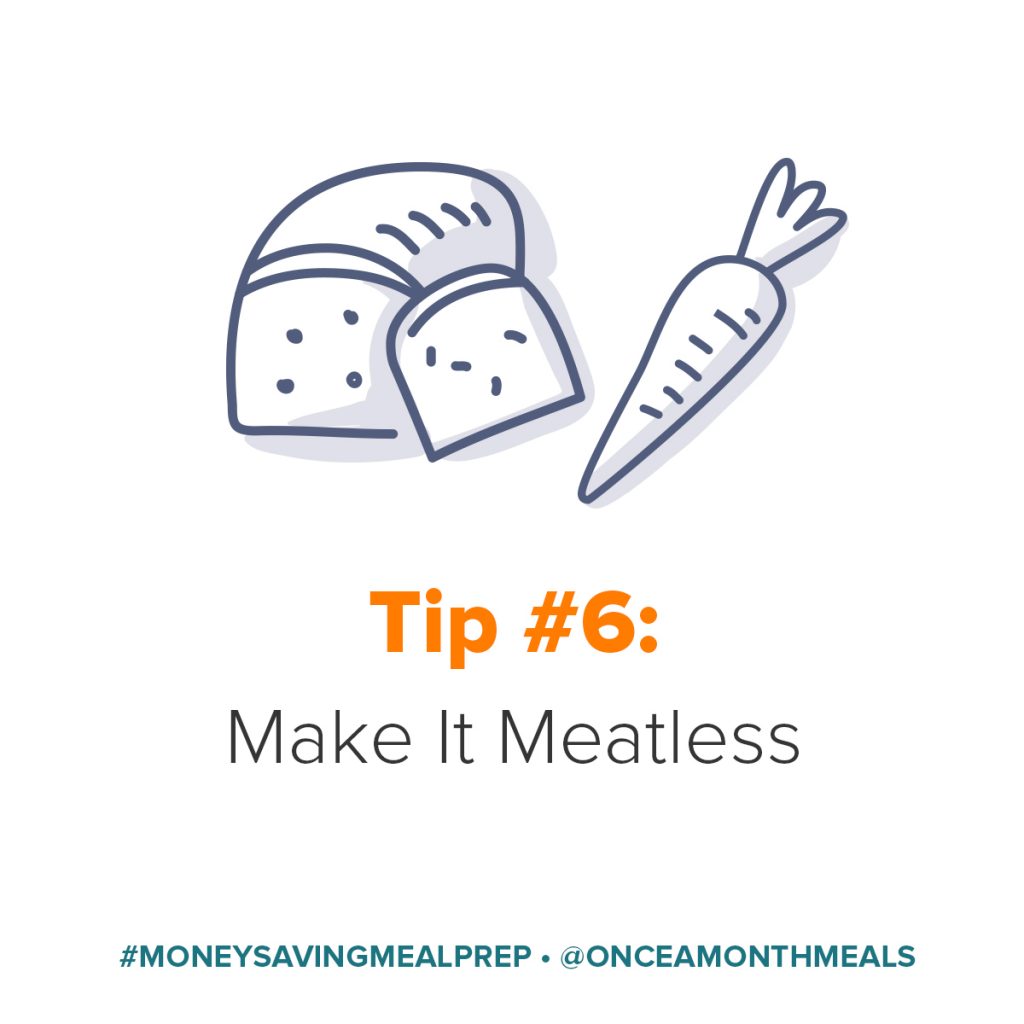
Tip #6: Make Your Meal Meatless
Don’t get us wrong, we LOVE meat, but let’s face it – it’s not cheap!
We know that prices differ by region and even by store, but it has been a long time since we’ve paid less than $1 a pound for any kind of meat. However, beans, grains, or even extra seasonal veggies can be found for at least half the price!
When you’re putting together your meal plan, choose recipes by replacing meat-heavy main dishes with vegetarian meals! (←You can do this easily at onceamonthmeals.com by filtering!)
But never fear, you don’t have to cut out meat altogether in the name of saving money when you’re meal planning!
How to implement meatless meals:
- Commit to one meatless meal a week
Meatless Mondays is always an easy way to remember it! - Make your dishes with less meat
For example, if a soup or casserole calls for 2 pounds of meat, you could use 1-1.5 pounds and just bulk up on the other main ingredients (veggies or grains). - Smaller portions with bulked-up sides
If you are cooking meat as the main dish (roast, steaks, etc.), you can serve smaller portions and add a large salad or a loaf of bread to your meal.
Meals for Meatless Inspiration!
Learn how to create your own custom plan from these recipes using our Membership.*
Drop us a veggie emoji (or two!) in the comments if you’ve tried any of these tips to save on meat!
*Keep in mind that with free membership there are some limitations.
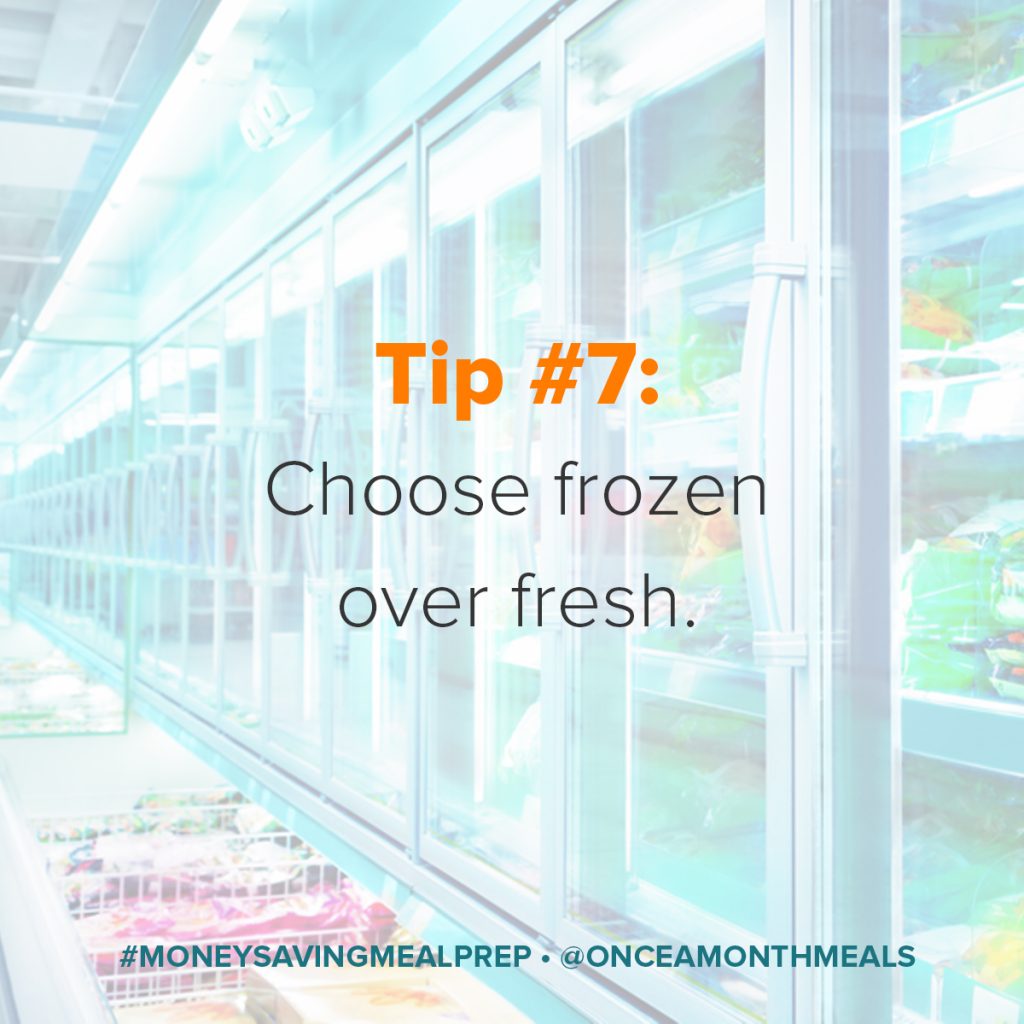
Tip #7: Choose frozen over fresh.
We know this sounds counter-intuitive, but trust us! Did you know that farmers and manufacturers freeze produce during the peak season to make it available year-round? That’s why you can often buy frozen fruits and vegetables for less than what you can get in the produce aisle!
Granted, this is not always the case, but it’s worth the comparison when you are at the grocery store if you’re really trying to watch your budget.
Here is a list of things to check for in the freezer aisle:
- green beans
- corn
- broccoli florets
- peas
- mixed veggies
- strawberries
- mango
- pineapple
- mixed fruit
- and SO many more
Obviously fresh is always nice, but sometimes you can find great deals on frozen fruits, veggies, and more to help cut down on what you spend regularly on produce!
However, the one thing that isn’t cheaper? Full meals.
In the case of Freezer Cooking vs. the Freezer Aisle, we are here to tell you that freezer cooking your own copycat freezer meals is way better than pre-made frozen meals! Here are three reasons why.
- The meals taste better. (Because well… you made it to your liking and needs!)
- They are healthier. (No added preservatives!)
- They are less expensive. (Especially if you have a lot of mouths to feed!)
We have a whole series of information about how to make meals better (and cheaper!) than the freezer aisle.
If you want more recommendations for delicious recipes you can make yourself, check out these 29 Copycat Freezer Aisle Recipes!
What’s your favorite go-to thing to purchase frozen over fresh?
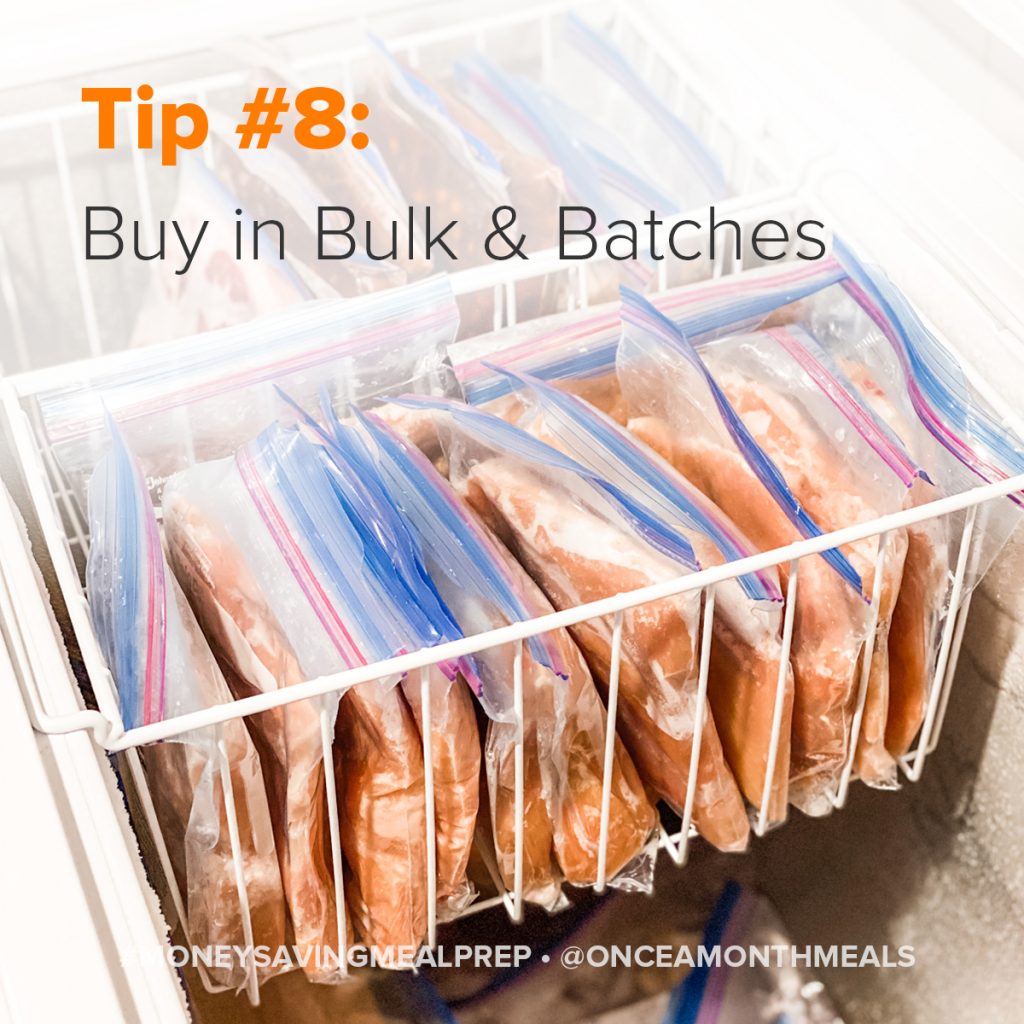
Tip #8: Buy in Bulk (or Batches)
This is an obvious tip for those who have a crowd to feed, but it can work for singles, working couples with no kids, retirees, and more! There are a few options for saving money when you’re meal planning.
Online:
Before you take your list straight to the grocery store, cross-check your local sale fliers with online coupon sites. Ordering special items online in bulk (i.e. gluten-free, dairy-free, some paleo and real food) can save you a special trip as well as few dollars.
Costco, Sam’s, BJs:
This is a fairly common one for large families who want to save on larger quantity items. For those of you out there who are single, we recommend getting a membership with a friend so you can share the perks!
Your local grocery store:
Check your weekly sales flier to see what’s on sale to stock up! Also, see if any of your local stores offer a discount for buying in bulk. Whole Foods is known for giving a 10% discount for buying items by the case, which has saved many on items like milk that rarely if ever, go on sale.
Fun fact: You can search our database for recipes by ingredient when you find a killer deal and want to stock up!
For example, if you keep seeing oatmeal is “buy one get one free” this month, search our database for all the recipes that contain oatmeal to use up your stash!
Comment below with what do you find yourself stocking up on!
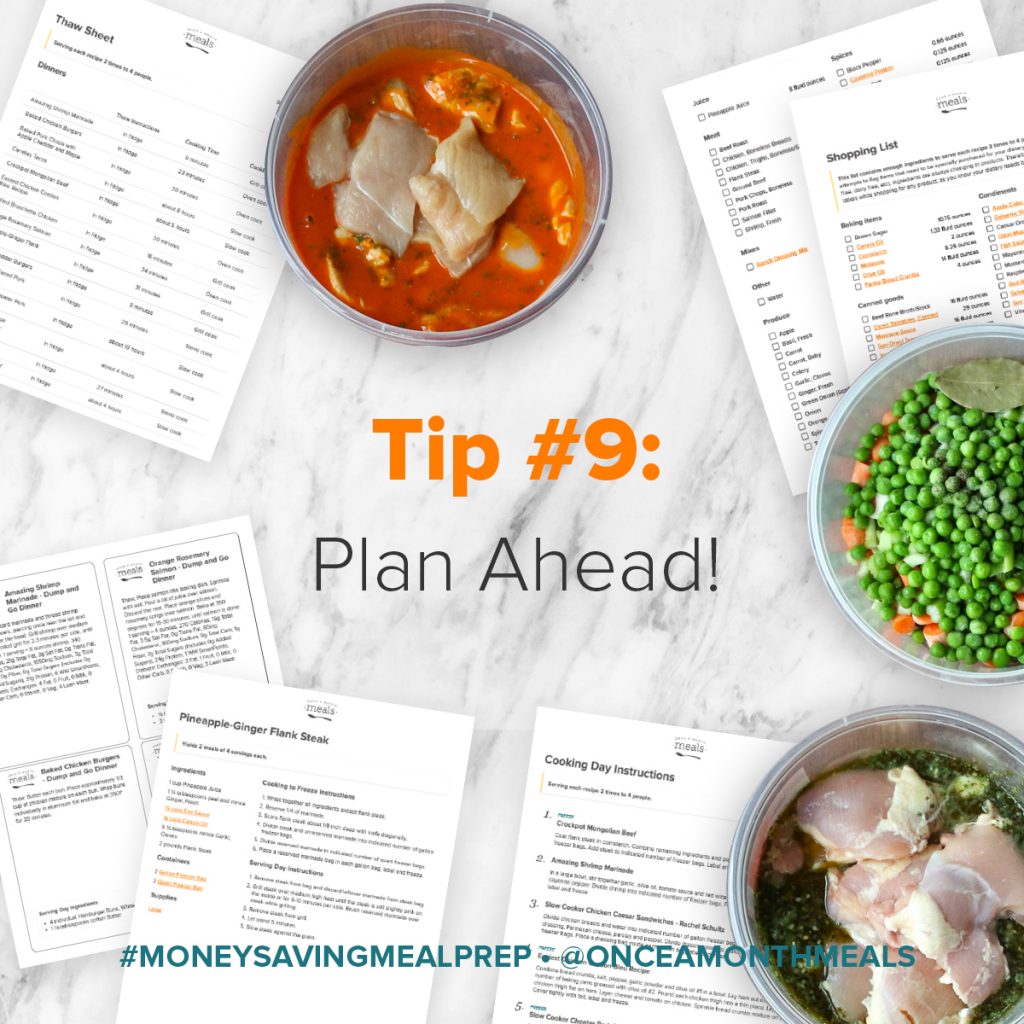
Tip #9: Plan Ahead!
This may seem silly, overly simple, and you’re honestly tired of hearing it… but it’s true.
Planning your meals and recipes ahead saves you money.
There really is no way around it. Why? Simply put, life gets hectic.
- You will always end up making last-minute trips to the store for that one thing you don’t have.
- You will make an unplanned drive-through visit on a school night with multiple kids’ practices.
- Your end of day meeting will run late and you’ll get home with no time to spare (or to think for that matter.)
- And on, and on, and on…
However, with a plan in place, you don’t have to stress constantly about “what’s for dinner?”
Now for many, this sounds good but is it really hard to implement. Yes? More often than not, we hear: “Just give me a plan to follow!”
At Once A Month Meals our goals for you are this:
- Stress Less
- Save Time
- Save Money
- Eat Better
We know families struggle to plan healthy meals to eat together. That’s why we’ve given you a system full of plans that are totally customizable to your needs.
Build meal plans for FREE!
Create a no-credit-card-needed OAMM membership account to explore and see if OAMM is the right fit for YOU!
You’ll be able to:
- search the 13,500+ freezer recipe database with hundreds of filters available.
- build and save for later use up to 3 meal plans of 5 recipes each.
- favorite recipes you find and want to try later or have cooked and love.
- view nutritional data of each recipe.
For more information on paid vs free membership check this out.
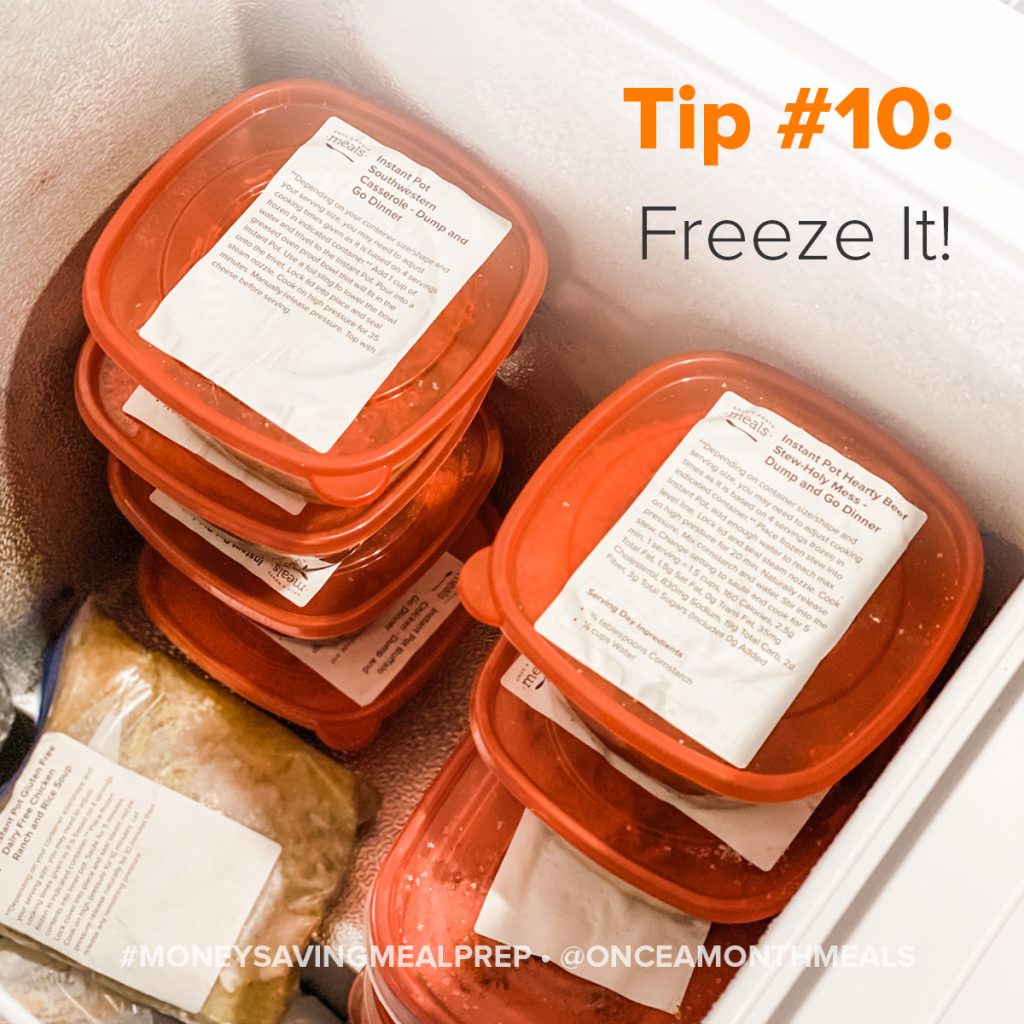
Tip #10: Freeze it!
Yes, you knew it was coming, but for good reason!
The freezer is the most overlooked appliance in your kitchen.
Yes, you obviously love your slow cooker, Instant Pot, air fryer, sous vide, and so on, but your freezer is secretly the one appliance you already have that, if utilized correctly, can save you L-O-A-D-S of money, and time.
“Freeze what?” you make ask. Well… Everything!
- Leftovers
- Full Meals
- Unused Ingredients
- and SO much more
Check out our post about What You Can and Cannot Freeze!
Take what’s unused and save it in the freezer to eat later!
Did you know the average meal or ingredient in the freezer lasts anywhere from 3-6 months? And that’s just the average! Imagine making your food go that much farther!
Sometimes items can last even longer in the freezer. The only thing you’ll notice is that the texture begins to change, but not the quality.
Get our Freezer Storage Cheat Sheet here to post on your fridge so you always know!
Here are some ideas below on what to start freezing:
- Freeze those extra leftovers from dinner last night into proportioned containers for lunches for the week.
- Blend up those herbs you have going bad with some butter or oil, and then freeze them in ice cube trays.
- Empty that half-used container of chicken broth you have in the fridge and freeze it in muffin tins to use for later.
- Freeze the extra cookie dough from a large batch and enjoy warm cookies later at a moment’s notice.
Seriously, whatever it is, there is a way to freeze it – saving money when you’re meal planning by not being wasteful and using everything to its fullest. You also save time, which is a wonderful feeling!
